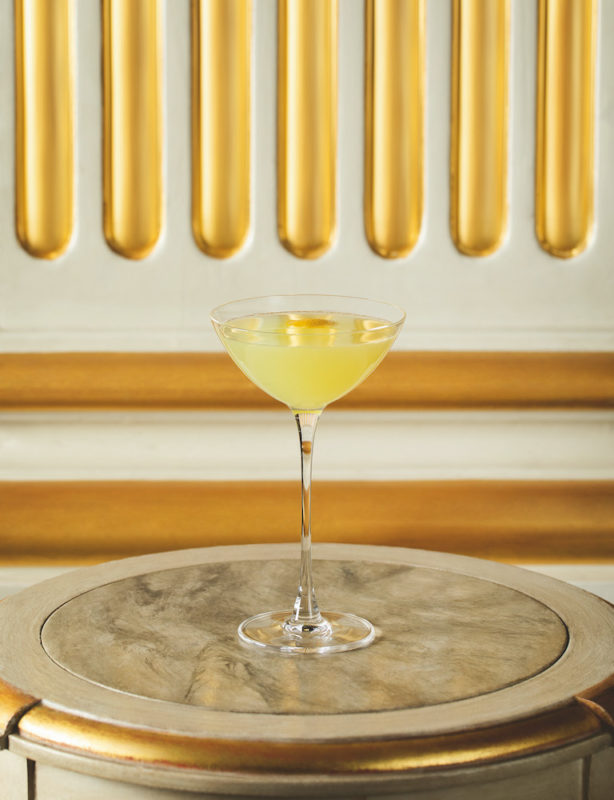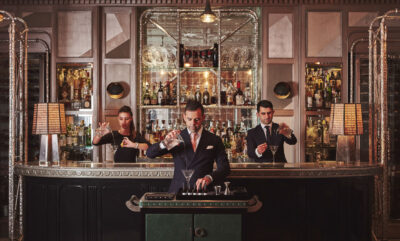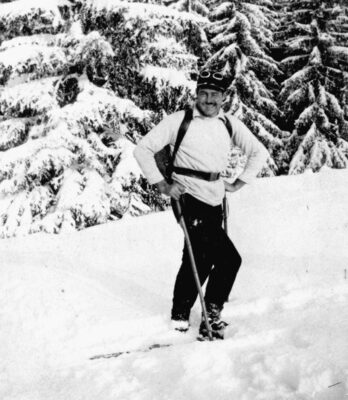
Cocktails
Mist & Chill
Claridge’s head bartender shares the secrets to a perfect cocktail in the iconic hotel’s new book.
In the theater of mixology, London’s famed Claridge’s Hotel is akin to the Royal Opera House. For over 150 years, the Mayfair mainstay has been at the forefront of the perfect cocktail and now, the iconic hotel presents its first imbibing guide, replete with over 500 cocktail recipes and wisdom from head bartender Denis Broci.
First published in the UK last fall and released in the U.S. on April 5, Claridge’s: The Cocktail Book (Mitchell Beazley) offers tips on everything from the art of crafting the perfect cocktail to must-have bar tools and recipes for classic and off-menu offerings.
The rich history of Claridge’s makes this a standout cocktail bible. While science is at the heart of the hotel’s storied creations—with an emphasis placed on proper proportions—the result is a total sensory experience for the 700 or so guests who grace the hotel’s three drinking establishments every day.
“Whatever a guest’s mood, a cocktail at one of Claridge’s bars ought to heighten, brighten, or lighten it,” says Broci, who joined Claridge’s as Director of Bars in 2008.


For decades, Claridge’s has created cocktails to reflect the times.
Long popular with members of Britain’s royal family, the hotel celebrated the 1952 coronation of Queen Elizabeth II. Broci and team delved deep into Claridge’s archives to honor her Platinum Jubilee this June.
“We will be mixing the ‘Windsor Rose’ which was served at the hotel to celebrate the coronation,” he says, describing it as “similar to a Cosmopolitan.” Several other cocktails will also be added to the menu. “Other cocktails will have a royal nod, too, and include The Royal Stag and Claridge’s Royal.”
More recently, mixologists created The Flapper to mark the launch of Claridge’s Bar in 1998. Designed to reflect the carefree spirit of the 1920s—a sentiment as relevant today as it was then—the signature crème de cassis–spiked Champagne cocktail is now the hotel’s most popular order.
The Flapper and The Royal Stag are but two of the over 500 recipes included in the elegantly illustrated guide.


The Flapper
1½ oz Briottet Crème de Cassis
½ oz Boiron strawberry purée
Laurent-Perrier La Cuvée NV Champagne, to top up
½ strawberry, to garnish
In a cocktail shaker, stir the crème de cassis and strawberry purée together, then fine-strain into a flute. Top up with Champagne and garnish with half a strawberry on the rim of the glass.
The Royal Stag
1½ oz The Dalmore 15
¾ oz Sweet Vermouth Blend
¾ oz Campari
2 dashes Bénédictine
2 dashes Bob’s Chocolate Bitters
1 dash Roasted Almond Tincture
Square of 75% dark chocolate, to garnish
Stir all ingredients in a mixing glass, then strain into a chilled rocks glass over an ice block. Garnish with a square of chocolate.
Windsor Rose
1½ oz vodka
1 oz Cointreau
1 oz cranberry juice
½ oz lime juice
1 tsp rose water
Rose petal garnish
Mix all ingredients over ice in a shaker, shake, and serve up with a rose petal garnish.
“To paraphrase William Morris, one must own nothing that you do not know to be useful or believe to be beautiful,” says Broci, a mantra that certainly translates to a well-equipped bar.
According to the master barman, one should have at least four kinds of serving glasses. And, as he expounds inside the book, “all glassware should be chilled before use. Whether on ice or not, a chilled glass makes a drink go from good to great.”
Broci recommends a minimum of four types of serving glass: Flutes for serving drinks containing Champagne; rocks for short drinks poured over cubed, crushed, or block ice; highballs for tall drinks poured over cubed or crushed ice; and coupes for short drinks served sans ice.
Is a very important lesson to be learnt. Movement should come from the wrist, not the elbow, fingers should be wrapped around the spoon, and there should be almost no noise against the glass. Practice makes perfect.
A simple, yet essential trick in Martini making is spritzing the glass. A simple mist ‘seasons’ the glass, complementing the drinking experience.
Shaking has a fourfold effect: Mixing, chilling, diluting, and giving texture, and is typically used for more-robust drinks containing citrus, juice, or sugar—cocktails that need force to mix them. For how long, it is impossible to state: You need to experiment and experience, in other words, taste, taste, taste. Under-shaking can result in an overly acidic cocktail, as the citrus element hasn’t been well diluted, or an overly alcoholic drink. Over-shaking can leave the flavors feeling flat.
When muddling, don’t press too hard, as this can fragment the ingredients and cause bitter flavors.
Cocktail garnishes aren’t just for show. They should always be adding something to the cocktail, whether taste or aroma.
Claridge’s – The Cocktail Book: More than 500 Cocktail Recipes for Every Occasion (Mitchell Beazley; £25)
Illustration: Clym Evernden; Photographs: John Carey



